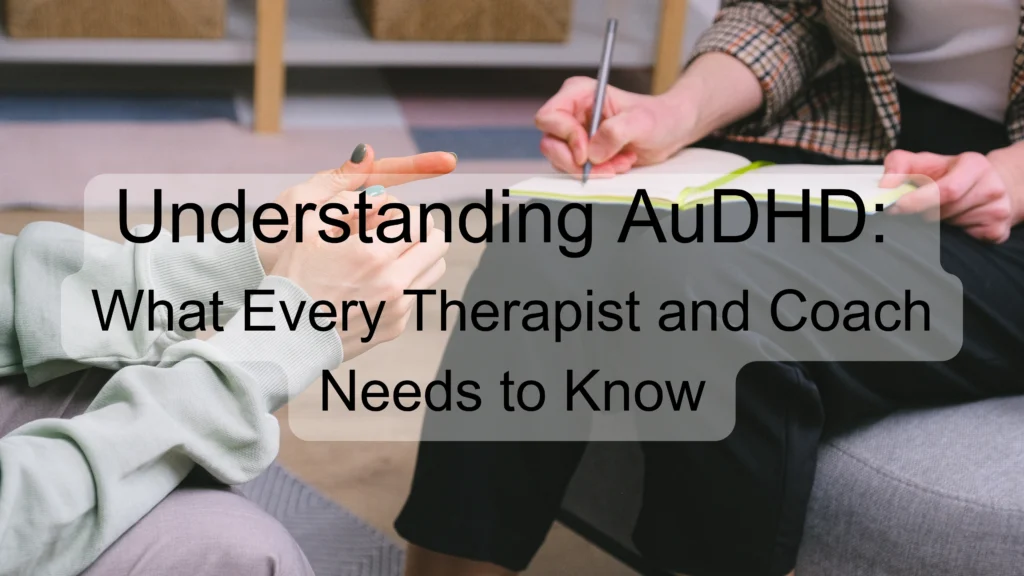Understanding AuDHD: What Every Therapist and Coach Needs to Know
Why You Need to Know About AuDHD—Now
If you’re a therapist or coach in 2025, chances are you’ve already worked with AuDHD clients—even if they (or you) didn’t know it at the time.
AuDHD refers to individuals who live with both Autism and ADHD. It’s not a diagnosis in itself—yet—but an increasingly used term to describe the dual neurotype that affects executive functioning, emotional regulation, communication, and sensory processing in often conflicting ways.
In the therapy room or coaching session, AuDHD can show up as contradiction:
- A client who swings between hyper-focus and brain fog,
- A woman who’s deeply articulate but reports “not feeling understood,”
- Someone who says, “I don’t know who I am anymore,” especially post-menopause.
These are not signs of resistance, ambivalence, or personality disorder. They are neurobiological truths—and they deserve to be recognised.
Quick Clinical Flags: How to Spot AuDHD in Women
Many women with AuDHD arrive in therapy burned out, anxious, and questioning their own sanity. Often misdiagnosed (or undiagnosed), they may have previously been labelled with:
- Generalised Anxiety Disorder
- Depression or Treatment-Resistant Depression
- Borderline Personality Disorder
- Bipolar II
- CPTSD
Here are some indicators that you may be working with an AuDHD client, especially in women and AFAB (assigned female at birth) individuals:
- Time Management Struggles + Perfectionism
They miss deadlines, yet their work must be “just right.” They feel shame over “laziness” but are in chronic overdrive internally. - Chronic Masking and People-Pleasing
They shape-shift to meet others’ expectations. You may notice a performance of wellness in session that crumbles between appointments. - Sensory Sensitivities + Intense Emotional Inner World
Lights, sounds, clothes, or food textures are quietly overwhelming. Emotional states are felt in surround-sound. - Rejection Sensitivity + Difficulty with Transitions
Even minor feedback feels like abandonment. They may describe everyday life as “too much,” “chaotic,” or “disorienting.” - Lifelong Feeling of Being “Different” Without Explanation
They often report a haunting sense of alienation since childhood, despite being socially skilled or high achieving.
The Mask Often Slips at Midlife
Menopause is the tipping point for many women with undiagnosed AuDHD. As oestrogen levels drop, executive functioning, emotional regulation, and sensory thresholds all shift. What was once manageable (albeit exhausting) now becomes overwhelming.
As a practitioner, you may notice:
- A client who was once “coping” is suddenly breaking down.
- Longstanding strategies stop working.
- A surge in existential questioning: “Who am I beneath all this?”
Rather than pathologise this moment, see it as a portal to truth. It may be the first time this woman is meeting her unmasked self.
Why Diagnosis May Be Irrelevant—Yet Deeply Healing
You do not need to diagnose. But you do need to understand.
A client may never receive an official diagnosis for autism or ADHD—especially in the UK’s underfunded system. But understanding AuDHD as a valid neurotype means you can work more compassionately and effectively.
Here’s what matters most:
- Let the client define their experience.
- Trust what may sound like paradox.
- Know that social masking is exhausting.
- Understand that “meltdowns” are nervous system responses—not manipulations.
- Recognise the gift as well as the grit.
Therapeutic and Coaching Adjustments That Make All the Difference
Working with AuDHD clients—especially women—requires adjustments in your style, expectations, and assumptions. Here are key principles:
- Slow Down the Pace
Time-blindness, processing delays, and social anxiety can all affect how a client takes in questions. Give them space to think, pause, and circle back.
- Be Mindful of Sensory Input
The therapy/coaching environment should be low-stimulus. Avoid overly bright lights, strong perfumes, or distracting visuals. Offer grounding tools when needed.
- Validate Emotional Intensity
Don’t try to dampen “big feelings.” Help the client explore, express, and work with their emotional inner world rather than pathologise it.
- Expect Inconsistency Without Shaming
Progress won’t always be linear. Hyperfocus one week may become shutdown the next. Remind clients this is a rhythm—not a regression.
- Name and Honour the Mask
Many clients don’t even realise how hard they’ve worked to appear ‘normal.’ Naming the mask helps loosen it—gently.
The Deep Gift of Working With AuDHD Clients
Clients with AuDHD are often among the most creative, perceptive, intuitive, and insightful people you will ever meet.
They bring:
- Deep empathy and spiritual awareness.
- Systems-level thinking that sees connections others miss.
- Radical honesty and profound pattern recognition.
- A hunger for authenticity and integrity in relationships.
When well-supported, they can become not just healed, but healers—writers, artists, coaches, therapists, activists, leaders. But it begins with us—how we listen, how we respond, and how we reframe their story from one of “what’s wrong with me?” to “what’s different—and precious—about me?”
Closing Reflection: The AuDHD Client Is the Canary and the Composer
They are the early warning signal in a world too fast, too bright, too loud. And they are also the composer—creating new rhythms for a more humane way of being.
As practitioners, our role is to:
- Hold space without judgment,
- Offer education without shame,
- Support transformation without erasure.
This is not about fixing them. It’s about freeing them.
Find more insightful blogs here or find me on Youtube @GraceChatting
Download your FREE Professional Cheat Sheet here

